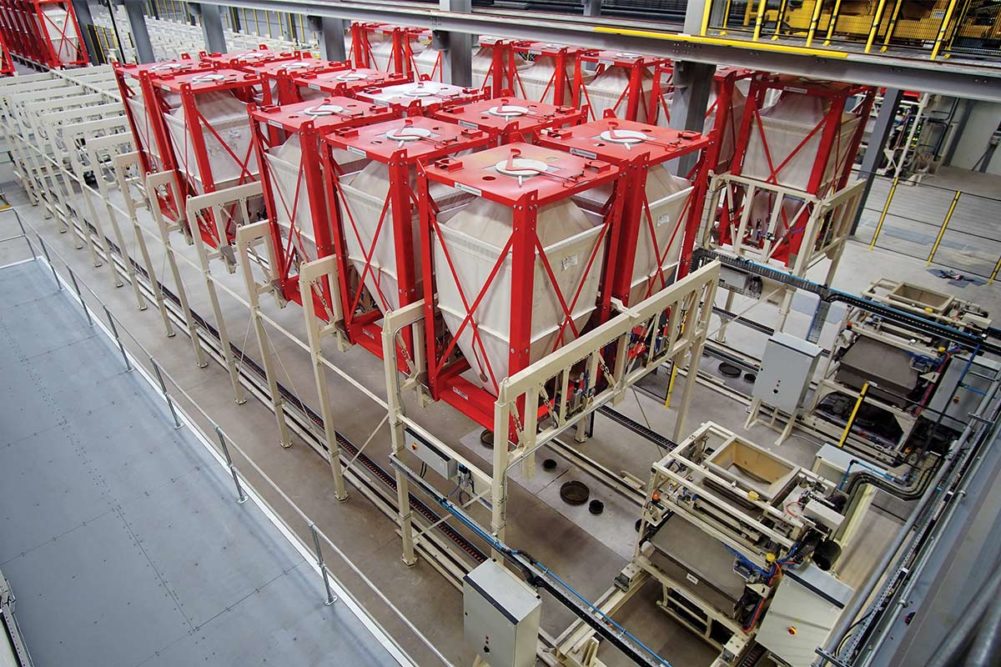This article was published in the September 2020 issue of Pet Food Processing. Read it and other articles from this issue in our September digital edition.
The successful production of high-quality pet food and treats is reliant on subsequent processes of portioning, mixing, extruding, baking and drying. Portioning is effectively used in pet food and treat processing to reduce waste without risk, necessitating the need to meet all weight and measurement statements without error while managing giveaway within tightly managed parameters. Accurate portioning technology also assures the perfect and balanced blend for processing to a finished product with the delicate balance of nutrients for the animal.
Depending on the product produced, portioning will include dry powder macro, medium and micro dosing with 20 to 40 ingredients per batch on average, as well as a couple of liquids and fresh meat additions. The importance of accurate portioning is the key driver for a consistent high-quality product, as noted by KSE Process Technology B.V., a producer of primarily dry powder dosing equipment based in Bladel, the Netherlands.
The portioning does not stop at the dosing of a raw ingredients with many final mixes being a combination of differently shaped, colored and sized kibbles. There are specific solutions available for the end-of-the-line proportioning of these mix-ins to provide a perfect blend in each bag.
“A mix of 30% A, 40% B and 30% C kibble combine to make a specific blend,” said Rob Habraken, technical consultant, KSE. “Not only to provide the right shapes and colors but also the correct nutrients for the pets’ specific breed and age. Some pet food processors go as far as to aim for packing specifically per customer. The value of proportioning is in the quality of the product, and the accuracy on the mix sets a large part of the final quality of the product and its effect on the pet.”
“The value of proportioning is in the quality of the product, and the accuracy on the mix sets a large part of the final quality of the product and its effect on the pet,” said Rob Habraken, KSE Process Technology B.V.
Proper portioning enables a manufacturer to create a consistent, repeatable product and ensures pets consume an adequate supply of nutrients without excess calories to maintain health and wellbeing. It also allows for exact tailoring of an animal’s unique needs.
“Excellent portioning is more valuable with pet food and treats that use higher quality, more expensive ingredients,” said Patrick McGady, national sales manager, Handtmann, Inc., Lake Forest, Ill. “As the movement toward human food quality continues, processors will be rethinking their new equipment specifications to ensure the ability to work within tighter portioning parameters for the lifetime of the equipment, not just when it’s new.”
Because of the many textures and forms in pet food products and treats, manufacturers offer a variety of equipment choices for effective portioning. One of the most common pieces of equipment being a rotary moulder with the ability to produce three-dimensional treats shaped by the cavities in the die. In addition to its rotary moulder, Reading Bakery Systems (RBS), Robesonia, Penn., supplies other portioning machines. Focusing on the production of two-dough products such as peanut butter treats, the company’s low-pressure extruder can also be used to sheet products. Wirecut machines uniformly cut individual shapes by an adjustable wireframe assembly and produce shaped products of a softer texture and higher water percentage.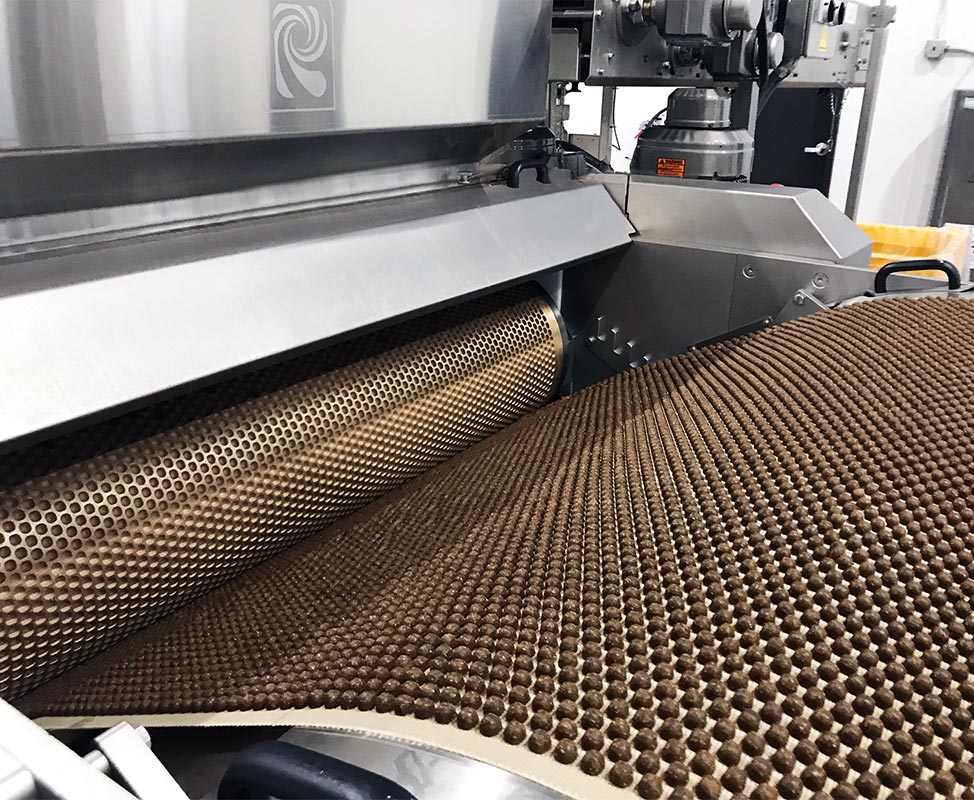
Creating consistency
Because portioning technology can have various levels of impact on finished product quality, meticulous controls must be in place. Factors influencing the quality of finished products include formulation, quality and quantities of ingredients used, attention to standard operating procedures (SOPs), time and temperature process controls, as well as the intensity of the machinery during processing that the product can withstand, according to Jeff Zeak, application specialist, Reiser, Canton, Mass.
Inconsistencies of the mix can impact the weight and shape of the product and the ability to obtain an even bake, creating significant deviation in the quality of the final product. Another impact to product quality can occur through friction, which causes product degradation. The hygienic design and servo-controlled precision of the Handtmann VF 800 with its adjustable vane cell feed system creates less of the product-to-surface contact that smears and degrades product, according to McGady. The company’s automated monitoring of critical feed system parameters provides a protective layer of safety that reduces risk and ensures consistent operation within product specifications.
Having additional safety measures in place is especially important when working with essential nutrients such as vitamin D. Although critical for bone development, heart functions, skin and coat health, vision, kidney function and immune system health, an overdose can be toxic or even fatal to an animal. Karen Neola, pack lead, My Perfect Pet, Poway, Calif., cautions portion control equipment for fresh, whole ingredients may not have the same level of sophistication, making precision critical to ensure perfect nutrient ratios. Tight controls on processes are necessary to ensure the finished product is safe and to avoid product recalls as a result of potentially dangerous levels of vitamins and minerals due to malfunctioning equipment, Neola added.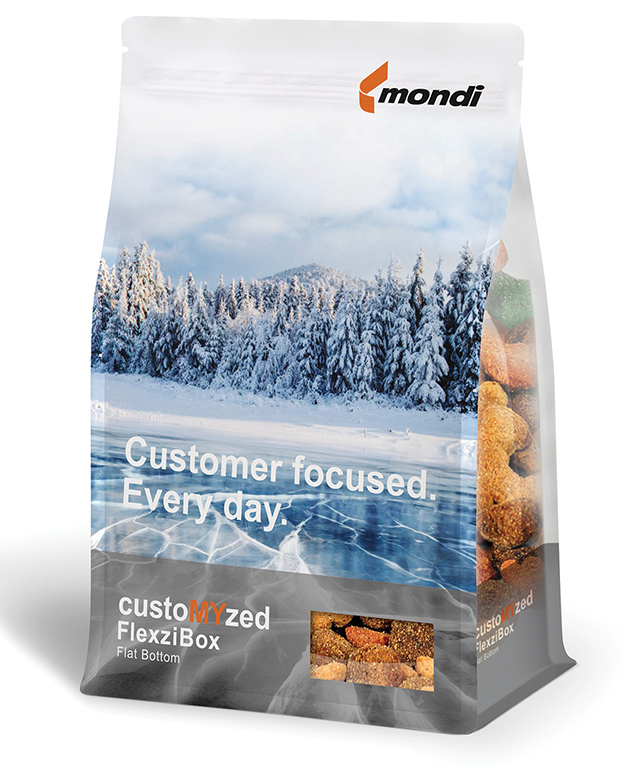
For finished product, when planning the final packaging portion sizes, it’s important to involve a packaging supplier early in the process, advised Bill Kuecker, vice president of marketing, Mondi Consumer Flexibles, Jackson, Mo.
“Early engagement with a packaging supplier can help ensure compatibility between fill/portioning equipment and your packaging approach,” Kuecker continued. “Partners with deep technical resources will supply samples, trial materials and useful input into the machine design process itself.”
Minimizing waste
Maintaining quality also means considering how to reduce unnecessary waste, a hot topic dovetailing with sustainability goals for consumers and manufacturers alike. Portioning technology can minimize waste on multiple levels from the amount of product giveaway to improved weight control standards. Controls on portioning technology reduce the time needed to rework product due to underweight portions that may be rejected at the process control weight check device.
Incorrect portioning might also translate into the necessity to scrap a batch. Just one incorrect dose can earmark a batch as waste. While that batch might be usable again as a product, it’s no longer a pure ingredient. While the choice of portioning method is dependent on process and product type, choosing the right equipment for the application further improves portioning effectiveness.
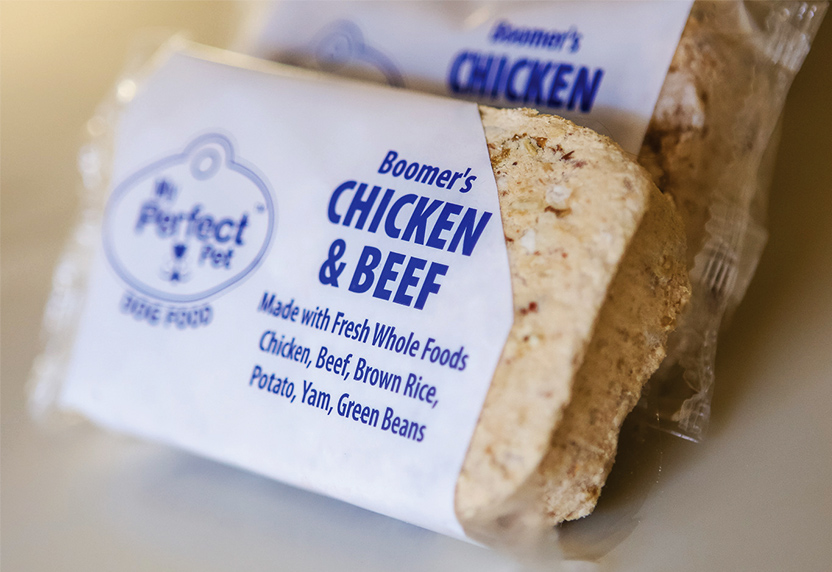
Efficiencies also arise with the elimination of foods inefficient in nutrient use. In other words, animals who do not receive the full healthful benefits will eliminate the excess waste.
“It’s like a giant puzzle where all pieces need to be there for the animal to use it,” Habraken said. “So, if a single piece is missing, basically all the other nutrients are voided as well, resulting in more animal fecal waste.”
“By giving consumers a portion-control food bar with instructions on how much of that bar to feed, they almost always feed the recommended amount,” said Karen Neola, My Perfect Pet.
To ensure control over the quality of its blends and a homogeneous mix when blending a large volume of fresh food with a small volume of supplement, My Perfect Pet does not use any premixed vitamin or mineral packs. The fresh food manufacturer performs all its own measuring and mixing in house to ensure control over every ingredient in its blends.
The vane cell design of Handtmann’s portioning technology minimizes product waste with an automatic weight compensation feature. Building in accuracy to each cell, the design allows even large portions of chunky products to be delivered with gram-level accuracy to Handtmann’s single- and multi-lane cutting, forming, extruding, co-extruding and depositing attachments.
For baked pet foods and treats, accurate portioning is often achieved through the use of a rotary moulder. RBS advocated that processors consider the variables of the extraction webbing, including the type of belting fabricate used and the coarseness of the weave. Other choices include a single or durometer rubber roll, with the hardness of the rubber taken into consideration.
“The selection of the webbing and rubber roll will depend from formulation to formulation and die shape to die shape,” said Sam Pallottini, director of biscuit, cookie and pet treat equipment sales, RBS. “When selected correctly, it will minimize tailing, extraction issues and product buildup.”
A flexible rotary moulder can accommodate a wide range of formulations, shapes and sizes. An adjustable gap allows for increasing and decreasing the blanket required on the forcing roll. The ability to adjust enables better control of the dough being fed into the smaller or larger cavities. A second drive provides additional power for forming the biscuits and the ability to speed up or slow down the forcing roll from the die roll to help fill up the range of cavities. Finally, a drive for the rubber roll minimizes the force required by the rubber roll for extracting out the biscuits, Pallottini shared.
While the rotary moulder does the heavy work in many baked pet food and treat facilities, processors are discovering applications for sheeting and two-dough products with the use of a low-pressure extruder. Softer treats using a wirecut system also provide an element of humanism to pet food and treats, according to Pallottini.
Frequent new product introductions means processors need the ability to push production to change over on the fly and respond with flexible scheduling. This necessitates keeping an eye on temperamental ingredients such as easily compactable powders that can result in poor product flow, in addition to the challenges of the tolerance of a weight range acceptability for a given product weight.
Temperature and cooling
Reigning in variability is critical when it comes to temperature and cooling in product processing, forming and portioning applications. The particular product, the process, the formula ratio, and the type of meat protein used with other ingredients can dictate at what temperature range the product will effectively portion, according to Zeak.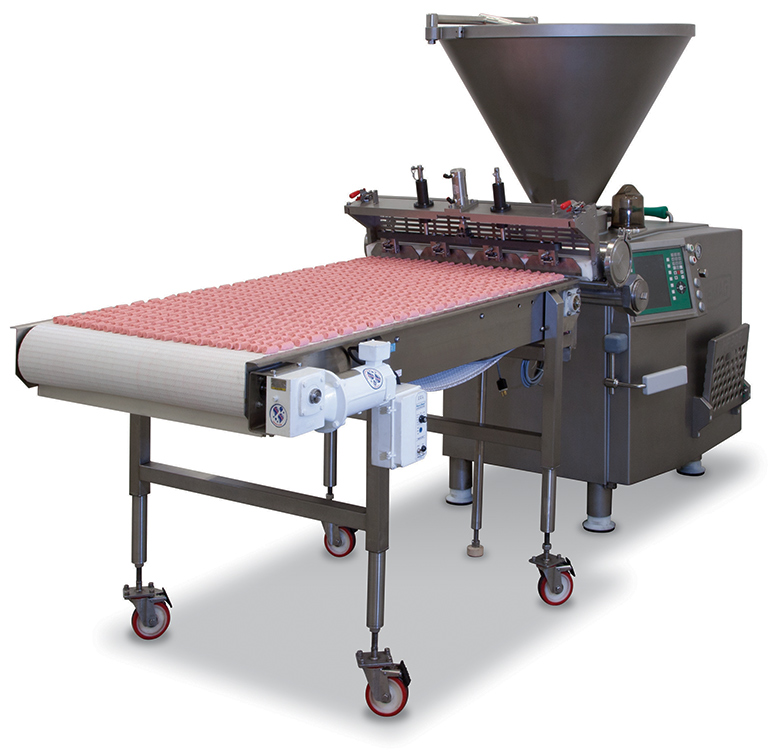
The presence of heat will also possess different flow characteristics. Dough exiting from the mixer too warm will likely be stickier and will bridge more, changing how it extracts from a rotary moulder, expands out of the wirecut head assembly, or handles in a low-pressure extruder. Temperature can also damage product quality, particularly when using equipment that does not have a weight compensation feature to ensure consistent portioning. Kibble that does not have time to cool and harden after the extrusion process can result in damage to raw materials and amino acids. Even with consistent climate control in facilities, seasonal differences and humidity levels can impact dough characteristics.
“Generally, higher percentages of meat protein used in the formulation require lower mixture temperature for forming and portioning,” Zeak said. “Product formulations containing high percentages of organ meats typically form and portion at temperatures below freezing. Meatball-shaped pet treat products form and portion best between 35 F to 45 F, depending on the formula make-up and the type of meat protein used.”
Zeak recommended temperatures above 32 F and approaching 40 F when portioning for use with HPP technology from the aspect of log Colony Forming Unit (CFU) kill rate effectiveness. There are also processes where higher temperatures are used for forming, portioning and food safety aspects. Some processes require a kill step of 160 F to 200 F before the product is cooled to 150 F to 190 F for processing, which offers fast set-up characteristics during cooling and before packaging.
When working with fresh foods, Neola recommended considering the juices and oils that can separate during the baking process. Because the nutrients in the juices and oils are factored into the nutritional profile of the bars, cooling becomes a critical step. Flash cooling of baked whole-grain brown rice in My Perfect Pet’s food bars converts the starch into a resistant starch. Temperature control is critical to reduce unnecessary expansion of the starch if the temperature drops too low.
Increasing safety
In addition to temperature control, ease of machine use, sanitation of the proposed system, short and direct product flow paths through the portioning device, and concerns regarding equipment design are important aspects of food safety when selecting a portioning system, Zeak shared. Equally important is the training of operators and sanitation staff personnel for machine SOP and best process practices regarding food safety and sanitation.
At RBS, best practices include the dual-purpose goal of safe food and safe equipment through its SafeShield Program. With every sale, RBS reviews the basic principles of the SafeShield Program with the customer. On the production floor, RBS enhances food safety through the use of continuous mixing. The mix can be quickly heated to the kill temperature within a range of one degree and then cooled through an automatic process that requires no handling or manual transporting of the dough.
Thorough cleaning of weighing systems helps to avoid cross contamination between subsequent batches, and reduction of dust reduces the chance of external influences getting into the product stream. Good practices include the use of equipment designs avoiding ledges, which could collect dust or create a risk for mold. KSE ensures food safety using good lot control and practicing a first-in, first-out flow of product from the silo.
In an age where worries about product safety and contamination continue to grow, portioning control applications offer a measurable level of security for both the consumer and the processor. Through the application of consistent and correctly dosed products and safe practices, pet food and treat manufacturers can create products that are uniquely tailored to the needs of the animals and pet owners they serve.
Find more articles about pet food processing equipment on our Equipment page.

